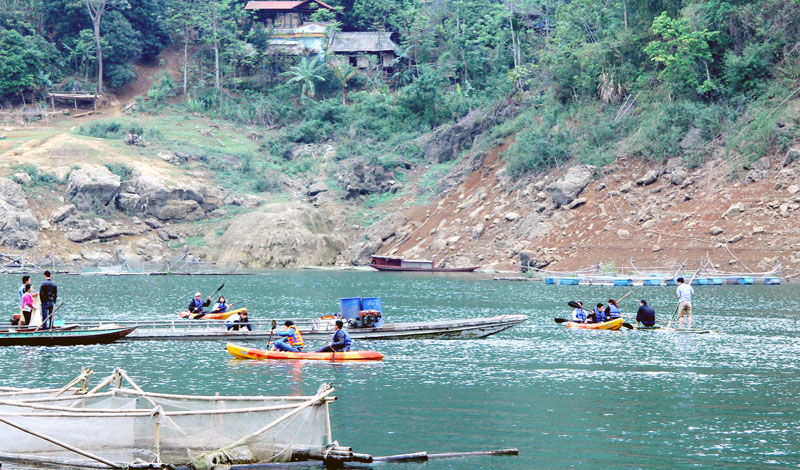
(HBO) - – Dua (Coconut) Island is a must-see destination to visitors who want to explore the Hoa Binh Lake area in the northern mountainous province of Hoa Binh.

Exploring
Hoa
Binh
Lake in
Dua
Island by raft .
Departing
from Thung Nai wharf, it takes about 30 minutes by boat to get
Dua
Island,
which is one of the most beautiful islands in the
Hoa
Binh
Lake in Vay Nua commune, Da Bac
district. Adjacent to the Chua Thac Bo temple, the 10-ha island is the meeting
venue of cloud and mountain.
Unlike other islands in the lake,
Dua
Island is covered with
the green of hundreds of coconut trees. Nguyen Dinh Tuy, owner of the island,
has spent time in planning, upgrading and seeking new varieties of coconut and
many other fruit trees to plant on the island.
Dua
Islandhas been developed into a tourist destination for many years with improved
service quality, meeting demands of visitors to explore the nature and culture
in the
Hoa
Binh
Lakearea.
Tuy
built big stilt houses of Muong and Thai ethnic groups on the island, with each
of them accommodating from 30-50 people, and eight small stilt houses equipped
with conveniences. There is a kitchen that can serve hundreds of people at the
same time, along with entertainment areas, allowing tourists to contemplate the
landscape, set up a campfire, fish and paddle boats. There are also houses for
small families on the island.
Vacationers can stroll around the island, freely pick fruits in orchards of
mango, sapodilla, longan and lychee, or paddle boats to visit surrounding
islands. They can also ride drug-out canoes at moonlight night and taste local
dishes hosted by the island owner like smoked fish, forest vegetables and roast
pork.
Tuy has also invested in passenger and motor boats to bring visitors to
surrounding tourist destinations like Thac Bo temple, Thac Bo cave, Tinh Yeu
(Love) waterfall, Ngoi Hoa bay, Hoa Tien cave, Coi Xay Gio (Windmill) island,
Xanh island and Ngoc island.
Thanks
to the power system and mobile service cover, holiday-makers can still access
information and handle their work while staying on the island.
Dua
Island has become an attractive
destination, luring a lot of visitors because of its primitive beauty.
A diverse chain of eco-tourism and resort destinations concentrated in Hoa Binh city and the districts of Tan Lac, Da Bac, and Luong Son… Along with the launch of several key high-quality resort tourism projects, these developments have reshaped the landscape and enhanced the appeal of Hoa Binh as a travel destination.
Boasting diverse terrain, a mild climate, and rich natural resources, Cao Phong district is increasingly asserting its place on Vietnam’s tourism map, attracting both domestic and foreign visitors. The district is renowned for its stunning landscapes, majestic mountains, a crystal-clear hydropower lake, and the unique cultural identity of local ethnic groups.
With its pristine landscapes, unique cultural heritage of Muong ethnic minority, and an expanding range of visitor experiences, Tan Lac district of Hoa Binh has fast become a captivating destination for both domestic and international tourists.
Until now, Sung village in Cao Son commune, Da Bac district remains the only Dao ethnic community in Hoa Binh province to develop a community-based tourism model. Beyond its untouched natural landscapes, cultural identity serves as the cornerstone attraction for visitors.
Alongside the diverse cultural identities of the Kinh, Muong, Tay, Thai, Dao, and Mong ethnic people, Hoa Binh province is also renowned as the "capital" of the northwestern Vietnamese cuisine, offering unique and distinctive dishes. At festivals, during Lunar New Year (Tet), or on significant family or community occasions, special dishes are prepared, leaving a lasting impression on visitors.
A Phong Linh (Yellow Tabebuia) flower garden in Thang village, Thach Yen commune, Cao Phong district is currently in full bloom, drawing a large number of visitors.



